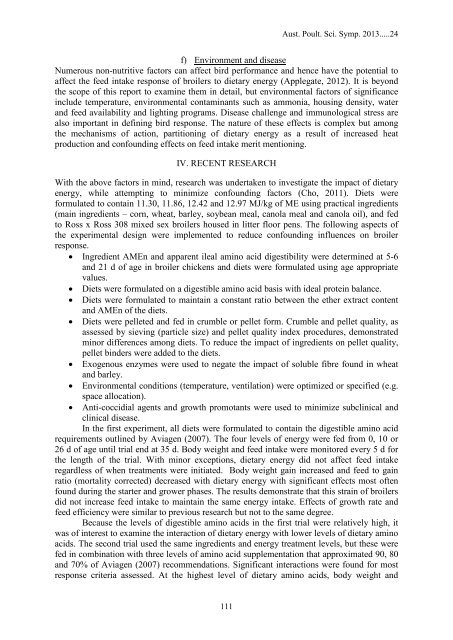APSS 2013 Proceedings - The University of Sydney
APSS 2013 Proceedings - The University of Sydney
APSS 2013 Proceedings - The University of Sydney
You also want an ePaper? Increase the reach of your titles
YUMPU automatically turns print PDFs into web optimized ePapers that Google loves.
Aust. Poult. Sci. Symp. <strong>2013</strong>.....24<br />
f) Environment and disease<br />
Numerous non-nutritive factors can affect bird performance and hence have the potential to<br />
affect the feed intake response <strong>of</strong> broilers to dietary energy (Applegate, 2012). It is beyond<br />
the scope <strong>of</strong> this report to examine them in detail, but environmental factors <strong>of</strong> significance<br />
include temperature, environmental contaminants such as ammonia, housing density, water<br />
and feed availability and lighting programs. Disease challenge and immunological stress are<br />
also important in defining bird response. <strong>The</strong> nature <strong>of</strong> these effects is complex but among<br />
the mechanisms <strong>of</strong> action, partitioning <strong>of</strong> dietary energy as a result <strong>of</strong> increased heat<br />
production and confounding effects on feed intake merit mentioning.<br />
IV. RECENT RESEARCH<br />
With the above factors in mind, research was undertaken to investigate the impact <strong>of</strong> dietary<br />
energy, while attempting to minimize confounding factors (Cho, 2011). Diets were<br />
formulated to contain 11.30, 11.86, 12.42 and 12.97 MJ/kg <strong>of</strong> ME using practical ingredients<br />
(main ingredients – corn, wheat, barley, soybean meal, canola meal and canola oil), and fed<br />
to Ross x Ross 308 mixed sex broilers housed in litter floor pens. <strong>The</strong> following aspects <strong>of</strong><br />
the experimental design were implemented to reduce confounding influences on broiler<br />
response.<br />
• Ingredient AMEn and apparent ileal amino acid digestibility were determined at 5-6<br />
and 21 d <strong>of</strong> age in broiler chickens and diets were formulated using age appropriate<br />
values.<br />
• Diets were formulated on a digestible amino acid basis with ideal protein balance.<br />
• Diets were formulated to maintain a constant ratio between the ether extract content<br />
and AMEn <strong>of</strong> the diets.<br />
• Diets were pelleted and fed in crumble or pellet form. Crumble and pellet quality, as<br />
assessed by sieving (particle size) and pellet quality index procedures, demonstrated<br />
minor differences among diets. To reduce the impact <strong>of</strong> ingredients on pellet quality,<br />
pellet binders were added to the diets.<br />
• Exogenous enzymes were used to negate the impact <strong>of</strong> soluble fibre found in wheat<br />
and barley.<br />
• Environmental conditions (temperature, ventilation) were optimized or specified (e.g.<br />
space allocation).<br />
• Anti-coccidial agents and growth promotants were used to minimize subclinical and<br />
clinical disease.<br />
In the first experiment, all diets were formulated to contain the digestible amino acid<br />
requirements outlined by Aviagen (2007). <strong>The</strong> four levels <strong>of</strong> energy were fed from 0, 10 or<br />
26 d <strong>of</strong> age until trial end at 35 d. Body weight and feed intake were monitored every 5 d for<br />
the length <strong>of</strong> the trial. With minor exceptions, dietary energy did not affect feed intake<br />
regardless <strong>of</strong> when treatments were initiated. Body weight gain increased and feed to gain<br />
ratio (mortality corrected) decreased with dietary energy with significant effects most <strong>of</strong>ten<br />
found during the starter and grower phases. <strong>The</strong> results demonstrate that this strain <strong>of</strong> broilers<br />
did not increase feed intake to maintain the same energy intake. Effects <strong>of</strong> growth rate and<br />
feed efficiency were similar to previous research but not to the same degree.<br />
Because the levels <strong>of</strong> digestible amino acids in the first trial were relatively high, it<br />
was <strong>of</strong> interest to examine the interaction <strong>of</strong> dietary energy with lower levels <strong>of</strong> dietary amino<br />
acids. <strong>The</strong> second trial used the same ingredients and energy treatment levels, but these were<br />
fed in combination with three levels <strong>of</strong> amino acid supplementation that approximated 90, 80<br />
and 70% <strong>of</strong> Aviagen (2007) recommendations. Significant interactions were found for most<br />
response criteria assessed. At the highest level <strong>of</strong> dietary amino acids, body weight and<br />
111
















